Introduction
Have you ever heard about the Bodhi Tree Bonsai? It’s not just any plant; it’s like a mini-history lesson with roots (pun intended!) in Buddhism and a symbol of enlightenment. Let’s dive right in!
The Bodhi Tree, known to science buffs as Ficus Religiosa, holds a special place in many hearts and cultures. Picture this: Siddhartha Gautama, who later became Buddha, found enlightenment right under this tree. ‘Bodhi’ means ‘awakening’ or ‘enlightenment’ in Sanskrit, which makes perfect sense, right?
Now, imagine having a scaled-down version of this majestic tree right in your living room. That’s where the Bodhi Tree Bonsai comes into play. Bonsai is an ancient Japanese art form. It’s all about growing miniature trees that look just like their full-sized counterparts.
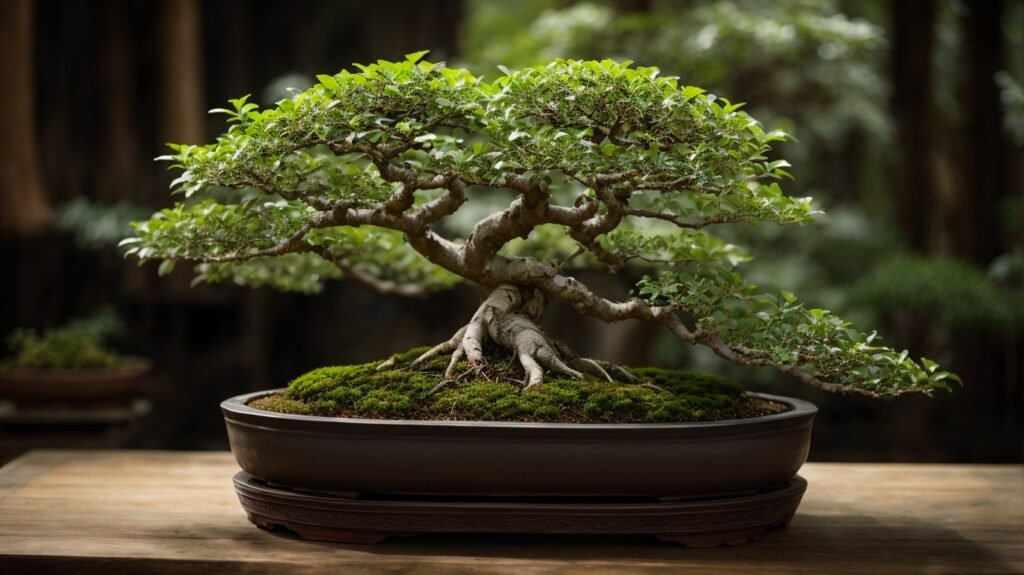
When you look at your Bodhi Tree Bonsai, you’re not just seeing a pretty plant. You’re looking at a symbol of wisdom, compassion, and the journey towards enlightenment. With its heart-shaped leaves and interesting root system, it’s a real head-turner. Plus, the rich history behind it adds an extra sprinkle of fascination.
So, are you ready to bring a piece of history and a touch of tranquillity into your home? Let’s embark on this exciting journey of cultivating your own Bodhi Tree Bonsai. We’re in this together, every step of the way!
| Key Points | Details |
|---|---|
| Scientific Name | Ficus Religiosa |
| Common Name | Bodhi Tree |
| Symbolism | Wisdom, Compassion, Enlightenment |
| Art Form | Bonsai (miniature rendition of full-sized trees) |
| Unique Feature | Heart-shaped leaves and intricate root system |
Understanding the Bodhi Tree Bonsai (Ficus Religiosa)
You’ve probably seen a bonsai tree before, but a Bodhi Tree Bonsai is something special. Let’s get to know it a bit better!
The Bodhi Tree, or Ficus Religiosa as the science world calls it, is native to India and Nepal. But guess what? It also feels at home in other tropical regions. The tree has a knack for reaching great heights – we’re talking up to 30 meters (almost 100 feet) tall!
| Feature | Description |
|---|---|
| Leaves | Heart-shaped with a unique tip |
| Bark | Greyish with a rough texture |
| Fruit | Small figs that are not edible |
| Height | Up to 30 meters in its natural habitat |
But don’t worry, your Bodhi Tree Bonsai won’t take over your living room. That’s the beauty of bonsai – it’s all about creating a miniature version of the tree that maintains the same proportions and features.
Bonsai, which translates to “planted in a container” in Japanese, is a true art form. It combines horticulture skills with artistic design principles. The goal? To create a small tree that mirrors the beauty of nature on a miniature scale.
The Bodhi Tree Bonsai, with its heart-shaped leaves and intricate root system, is a perfect candidate for bonsai. When grown and shaped with care, it embodies the grace and tranquillity of the full-sized Bodhi Tree.
So, you’re not just growing a plant; you’re crafting a piece of living art. And the best part? This art form brings with it a sense of peace and enlightenment. Excited yet? We sure are!
Starting Your Bodhi Tree Bonsai Journey
Alright, so you’re ready to start your Bodhi Tree Bonsai journey. Fantastic! The first step is choosing the right tree. But how do you do that? Here are some handy tips:
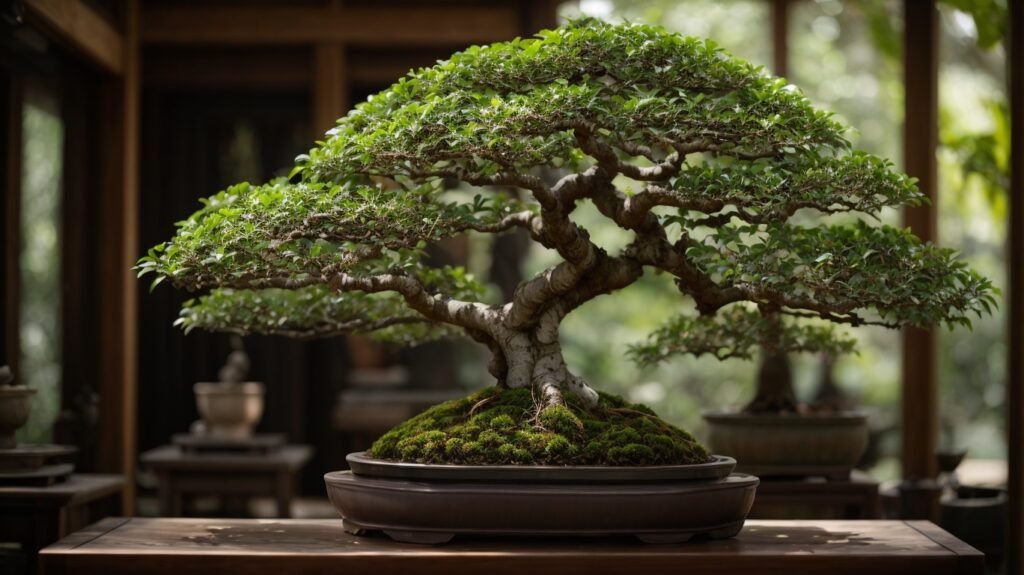
- Selecting a Style: There are several styles of bonsai, including formal upright, informal upright, and more. Choose a style that speaks to you and suits your Bodhi tree’s natural growth pattern.
- Tree Age and Size: When selecting a Bodhi tree for bonsai, opt for a young tree with a straight trunk and a well-shaped canopy. The size of the tree you choose should also fit the space you have available.
- Identifying Features: Pay attention to the stem of the tree, the leaves, flowers, fruit, seeds, and bark. These features can give you clues about the tree’s health and suitability for bonsai.
- Growing Conditions: The Bodhi tree thrives in warm climates and doesn’t like extreme cold or over-watering. Make sure you can provide the right conditions for your tree.
Once you’ve considered these factors, it’s time to buy your Bodhi tree. You can find them in online marketplaces or local nurseries. Just remember to choose a reputable seller to ensure you’re getting a healthy tree.
| Considerations | Description |
|---|---|
| Style | Choose a bonsai style that fits your vision and the tree’s growth pattern |
| Age & Size | Opt for a young tree with a straight trunk and well-shaped canopy; consider your available space |
| Identifying Features | Look at the stem, leaves, flowers, fruit, seeds, and bark |
| Growing Conditions | Ensure you can provide the right conditions: warm climate, no over-watering |
Cultivating Your Bodhi Tree Bonsai
Alright, let’s roll up our sleeves and get into the nitty-gritty of growing your Bodhi Tree Bonsai. Don’t worry, we’re with you every step of the way!
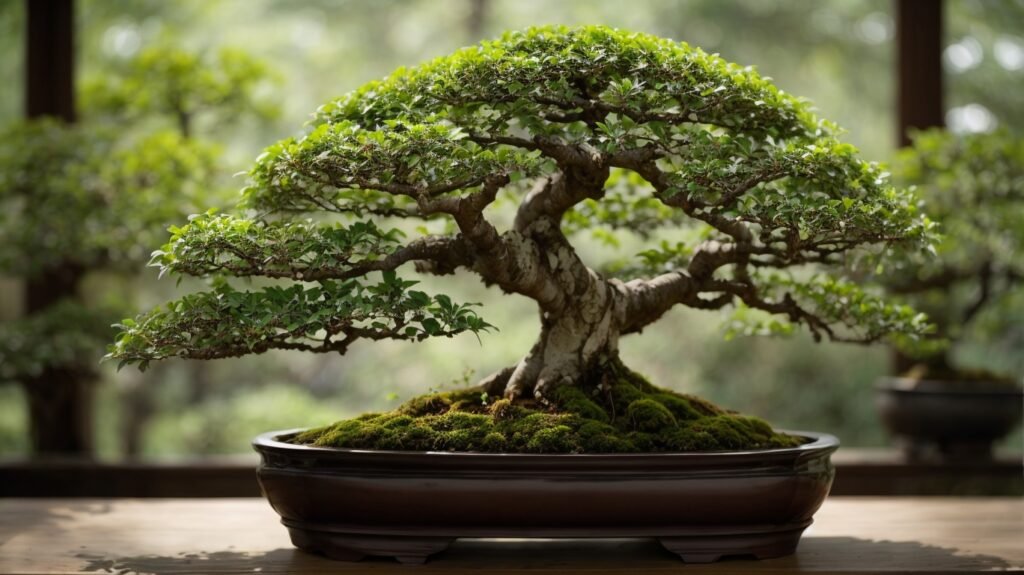
Step-by-Step Guide to Growing a Bodhi Tree Bonsai
- Choosing Your Tree: As we discussed earlier, choose a young Bodhi tree that fits your vision and available space.
- Selecting the Right Container: The pot should be shallow and wide enough to accommodate the roots of the tree. Make sure there are drainage holes!
- Preparing the Soil: Bodhi trees prefer well-draining soil. A mix of organic compost, gravel, and coarse sand works well.
- Planting: Place the tree in the container and gently spread out its roots. Then cover the roots with the soil mix.
- Watering: Water your Bodhi tree thoroughly right after planting. After that, water it when the top inch of soil feels dry. Remember, Bodhi trees don’t like over-watering.
- Positioning: Place your bonsai in a bright location, but not in direct sunlight. The Bodhi tree prefers warmth, so avoid cold drafts.
- Pruning & Training: Once your tree starts growing, you can prune it to maintain its shape and train it to grow in your desired style.
| Growing Conditions | Description |
|---|---|
| Watering | Water thoroughly after planting; then only when top inch of soil is dry |
| Soil Type | Well-draining soil; mix of organic compost, gravel, coarse sand |
| Climate | Prefers warm conditions; avoid cold drafts |
Care and Maintenance of Your Bodhi Tree Bonsai
Keeping a Bodhi Tree Bonsai healthy and beautiful is an ongoing commitment. Here’s what you need to do to keep your tree thriving:
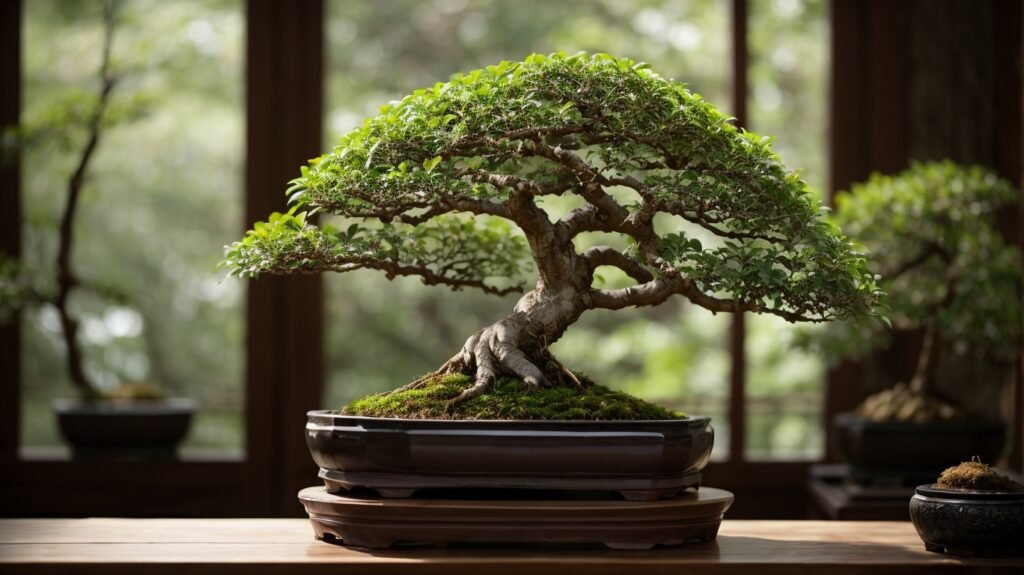
Routine Care
- Watering: Overwatering can be fatal for a Bodhi Tree Bonsai. Water the tree only when the top inch of soil feels dry.
- Pruning: Regular pruning helps maintain the miniature size and shape of your bonsai. Use a sharp, clean tool to make precise cuts.
- Fertilizing: During the growing season (spring and summer), fertilize your bonsai every two weeks with a balanced bonsai fertilizer.
Dealing with Challenges
- Overgrowth: If your bonsai starts growing too large, it may need more frequent pruning or a smaller pot.
- Pests: Keep an eye out for common pests like aphids and scale insects. If you notice any, use a gentle insecticidal soap.
- Disease: Signs of disease include yellow leaves or slow growth. If you suspect a disease, consult with a local nursery or extension service.
Remember, every tree is unique and may require slightly different care. Observe your tree closely and adjust your care routine as needed. And most importantly, enjoy the process!
| Routine Care | Description |
|---|---|
| Watering | Only when top inch of soil is dry |
| Pruning | Regularly, with clean, sharp tools |
| Fertilizing | Every two weeks during growing season |
| Potential Challenges | Solution |
|---|---|
| Overgrowth | More frequent pruning or smaller pot |
| Pests | Insecticidal soap |
| Disease | Consult with local nursery or extension service |
Appreciating the Beauty of Your Bodhi Tree Bonsai
Once you’ve nurtured your Bodhi Tree Bonsai and it’s thriving, it’s time to showcase it in all its beauty. Here’s how:
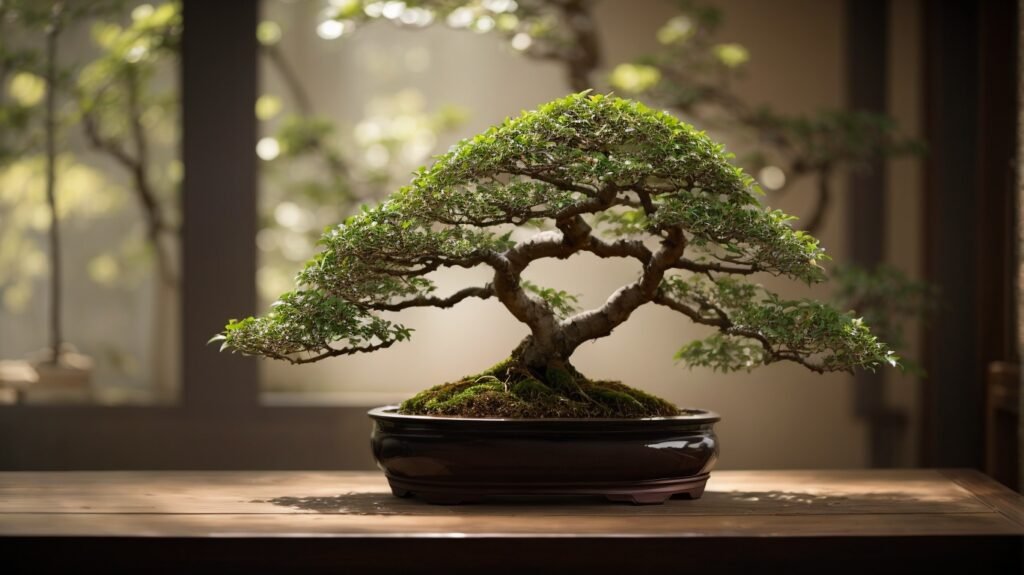
Displaying Your Bodhi Tree Bonsai
- Choosing the Right Spot: Your bonsai should be displayed in a spot that gets plenty of indirect light. It could be a window sill, a balcony, or even a well-lit room.
- Positioning the Tree: The tree should be positioned off-center in the pot for the best visual balance.
- Creating a Backdrop: A simple backdrop can help highlight the beauty of your bonsai. This could be a plain wall, a piece of fabric, or even another plant.
- Using a Stand: A stand can elevate your bonsai and give it more presence. Choose a stand that complements the style of your bonsai.
Spiritual and Meditative Benefits
Tending to a Bodhi Tree Bonsai isn’t just about creating a beautiful miniature tree; it’s also a form of meditation and spiritual practice.
- Mindfulness: The act of caring for a bonsai requires attention and focus, helping you stay present in the moment.
- Patience: Bonsai trees grow slowly, teaching you the value of patience and the beauty of slow progress.
- Connection with Nature: Tending to your Bodhi Tree Bonsai helps you forge a deeper connection with nature, which can be calming and grounding.
In the end, the most important thing is to enjoy the journey of growing and caring for your Bodhi Tree Bonsai. It’s a labor of love that can bring you peace, joy, and a sense of achievement.
Conclusion
In conclusion, growing and caring for a Bodhi Tree Bonsai is both an art and a journey. It starts with choosing your tree and the right container, preparing the soil, and planting. This is followed by regular care, which includes watering, pruning, and fertilizing. But it doesn’t end there. You’ll also need to face challenges such as overgrowth, pests, and diseases.
Once you’ve navigated these steps, you get to enjoy the beauty of your Bodhi Tree Bonsai. Display it in a spot that highlights its beauty and complements your decor. The process of tending to your bonsai also brings spiritual and meditative benefits. It fosters mindfulness, patience, and a deeper connection with nature.
Growing a Bodhi Tree Bonsai may seem daunting at first, but remember, it’s a journey meant to be savored. Each step, each challenge, and each victory is part of the process. So why not start your own Bodhi Tree Bonsai journey today? Enjoy the process, appreciate the beauty, and reap the rewards of your hard work and patience. Happy bonsai growing!
Frequently Asked Questions (FAQs) about Bodhi Tree Bonsai
How often should I water my Bodhi Tree Bonsai?
Only when the top inch of the soil feels dry. Overwatering can be harmful to the tree.
How frequently should I prune my Bodhi Tree Bonsai?
Regular pruning is essential to maintain the shape and size of your bonsai. The frequency depends on the growth rate of your tree.
When should I fertilize my Bodhi Tree Bonsai?
Fertilize your tree every two weeks during the growing season, which is typically in the spring and summer.
How do I deal with overgrowth in my Bodhi Tree Bonsai?
Overgrowth can be controlled with more frequent pruning or by using a smaller pot.
What should I do if there are pests on my Bodhi Tree Bonsai?
Use a gentle insecticidal soap to get rid of common pests like aphids and scale insects.
What are the signs of disease in a Bodhi Tree Bonsai?
Signs of disease may include yellow leaves or slow growth. If you suspect a disease, consult with a local nursery or extension service.
Where should I display my Bodhi Tree Bonsai?
Choose a spot that gets plenty of indirect light, such as a window sill, a balcony, or a well-lit room.
How can I position my tree for the best visual balance?
The tree should be positioned off-center in the pot for the best visual balance.
What are the spiritual benefits of tending to a Bodhi Tree Bonsai?
Tending to a bonsai can foster mindfulness, patience, and a deeper connection with nature.
Can beginners grow a Bodhi Tree Bonsai?
Absolutely! While it requires patience and care, beginners can definitely take up the rewarding journey of growing a Bodhi Tree Bonsai.
Further Reading and Resources
- The Charming Lemon Cypress Bonsai: A Comprehensive Guide
- The Exquisite Art of Growing Rainbow Eucalyptus Bonsai: A Comprehensive Guide
- Mastering the Art of Southern Magnolia Bonsai: A Comprehensive Guide
- Mastering the Art of Yoshino Cherry Bonsai: A Comprehensive Guide
- Cultivating a Fiery Beauty: A Comprehensive Guide to Flame Tree Bonsai
- Mastering the Art of Rocky Mountain Pine Bonsai: A Comprehensive Guide





